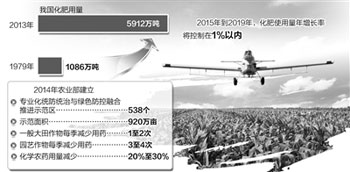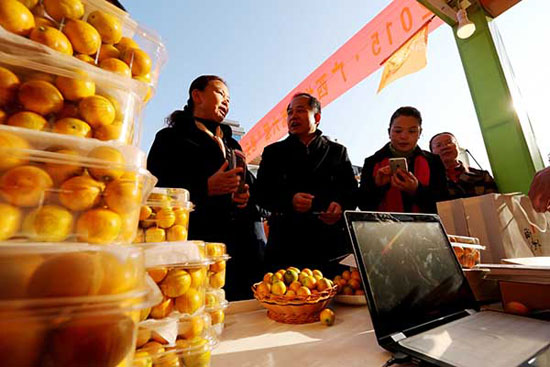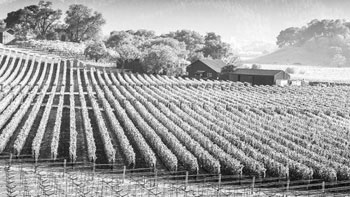Crops reduce "fat" to become well-off and achieve zero growth in five years
Original title: China strives to achieve zero growth in chemical fertilizer use by 2020
Crops become less "fat" and agriculture is more beautiful (new ideas lead new practices)

China proposes to achieve zero growth in the use of chemical fertilizers and pesticides by 2020 (photo source: economic Daily)
The Fifth Plenary session of the CPC Central Committee put forward: "to uphold green development, we must adhere to the basic national policy of saving resources and protecting the environment, adhere to sustainable development, firmly follow the civilized development path of production development, affluent life, and good ecology." we will speed up the construction of a resource-saving and environment-friendly society, form a new pattern of harmonious development of modernization between man and nature, promote the construction of a beautiful China, and make new contributions to global ecological security. "
China's grain production has had another bumper harvest this year, and compared with previous years, this year's bumper harvest has given more "green" connotations. Thanks to the action of zero growth in the use of chemical fertilizers and pesticides carried out by the agricultural sector and a series of supporting technical measures, the utilization rate of chemical fertilizers and pesticides in China has increased steadily this year. The utilization rate of chemical fertilizer for the three major grain crops, rice, corn and wheat, was 35.2%, an increase of 2.2% over 2013; the use of urea was reduced by 1 million tons, and farmers reduced production investment by about 1.8 billion yuan. It is estimated that the reduced fertilizer input is equivalent to reducing nitrogen emissions by 478000 tons and saving 1 million tons of coal, and the mode of production of large amounts of water and fertilizer is changing.
Is it possible to apply less chemical fertilizer?
Wei Shilian, a big grain grower in Jinchuan Town, Xingan County, Ji'an City, Jiangxi Province, has tasted the benefits of less fertilization this year. "in the past, fertilization was a 'one-shot'. As soon as the rice seedlings were planted for a week, all the fertilizer was sprinkled. This year, the fertilizer was applied in stages and postponed, with only 60% applied at the first time, and the rest was applied in two stages depending on the situation."
Why did you change it like this?
Wei Shilian, like a technical expert, put it eloquently: "after one application, the seedlings grew fast in the early stage, but the stamina was not enough; the application in stages reduced the amount of fertilizer used, controlled the ineffective tillering, and improved the utilization rate of fertilizer." In this way, fertilization is also beneficial to the prevention and control of diseases and insect pests, with fewer ineffective tillers, better ventilation and light transmission in paddy fields, and fewer opportunities for the occurrence of diseases and insect pests. "
Old Wei calculated an account, so fertilizing an mu of land can save 30 jin of chemical fertilizer, pesticides also saved about 15 yuan, the overall cost savings of 50 or 60 yuan. Yao Yigen, director of the Xingan County Agricultural Technology extension Center, said: "this year, we are mainly promoting the 'three controls and one reduction' technology, that is, controlling soil acidification, the decline of land control power, controlling the use of chemical fertilizers and reducing the use of pesticides, so as to achieve green production."
"I have planted 1000 mu of late rice this year, saving 30 jin of fertilizer per mu and increasing 60 jin of grain, and the harvest is really good!" Wei Shilian told reporters that do not underestimate these 60 jin of grain, large households have a large planting area, an increase of 5 jin per mu.
"A single flower in a crop depends entirely on fertilizer." Zhang Fusuo, a professor at the School of Resources and Environment at China Agricultural University, told reporters that chemical fertilizer is the "food" of crops, and studies have shown that it contributes 30% to grain production. 50%. For example, vegetable crops generally have a short growth period, with a yield of more than 10,000 jin per mu. If there is not enough fertilizer support, a crop will consume the nutrient accumulation of the land for many years, and a bumper harvest is unthinkable. Therefore, in order to have a correct understanding of chemical fertilizer, scientific and rational use is the key.
"while seeing the efforts of chemical fertilizers, we cannot avoid the problems caused by excessive application of chemical fertilizers and pesticides blindly." Zeng Yande, director of the planting Management Department of the Ministry of Agriculture, said: under the circumstances that the factors of resources are very tight, the planting efficiency is still on the low side, and the pressure on the environment is increasing, the development mode of relying on a large amount of resources and consuming the environment has become unsustainable. we must change the mode of development and vigorously promote scientific fertilization and pesticide application. Under this background, China has put forward the goal of zero growth in the use of chemical fertilizers and pesticides by 2020.
As for chemical fertilizer, the goal of zero growth is that by 2020, the utilization rate of chemical fertilizer will reach more than 40%, an increase of 7% over 2013, and strive to achieve zero growth in the use of chemical fertilizer for crops. "from 2015 to 2019, we will gradually control the annual growth rate of chemical fertilizer use to less than 1%, and strive to achieve zero growth in chemical fertilizer use of major crops by 2020." Zeng Yande said that to reduce "fertilizer" is not simply to reduce chemical fertilizer, but to take a variety of measures to subtract unreasonable fertilization and improve efficiency, which will not affect the safety of agricultural products supply.
What is the gap between China and foreign countries in the utilization rate of chemical fertilizer?
So, what is the current situation of chemical fertilizer use in China?
Statistics show that the annual use of chemical fertilizer in the country is more than 58 million tons, ranking first in the world, while the utilization rate of chemical fertilizer is relatively low. Zeng Yande said that in the world, nitrogen fertilizer use efficiency in the current season is generally used to reflect the utilization rate of chemical fertilizer. After chemical fertilizer is applied into the soil, there are generally three destinations: first, it is absorbed by crops in the current season; second, it remains in the soil, as a soil nutrient, it can be absorbed and utilized by crops in the next season; third, it is lost to the atmosphere and water environment. At present, the nitrogen use efficiency of food crops in the United States is about 50%, while that of food crops in major European countries is about 65%, which is 15% and 30 percentage points higher than that in China.
"there is a big gap in the utilization rate of chemical fertilizer between China and foreign countries, but the reasons should also be analyzed objectively." Zeng Yande said.
The gap first of all comes from the difference of soil fertility. "most of the cultivated land in China is medium-and low-yield land, accounting for about 70 percent. Although the state has strengthened the construction of farmland infrastructure in recent years, due to the development of industrialization and urbanization, the quality of supplementary cultivated land in the balance of occupation and compensation is poor, generally with a difference of 2 Mel and 3 grades. At present, the contribution rate of basic soil productivity in China is about 50%, which is 20% lower than that of developed countries. " Zeng Yande said: the content of organic matter in the black soil region of northeast China, which is the best in China, is now only about 3 percent, which is 2 percentage points lower than that of the "Sautéed Sweet Corn with Salted Egg Yolk Belt" in the Great Lakes region in the central United States and the main corn producing area in the Amazon Basin of Brazil.
The second is the difference of planting system. The utilization intensity of land and other resources in China is high, which is more than one year in some places in the south, twice a year in Huang-Huai-Hai region, and once a year only to the north of the Great Wall. In Europe, America and other countries, most of them are ripe once a year, and the soil fertility keeps better.
The third is the difference of crop yield level. Because of the situation of large population and little land, China has chosen to increase input to improve the level of per unit yield. Take rice as an example, the yield per mu of rice in China is nearly twice that of India, and the level of fertilization is 67% higher; the yield per mu is 25% higher than that of Japan, and the level of fertilization is 30% higher.
The fourth is the difference between tillage and fertilization. Europe and the United States and other countries through the implementation of deep ploughing and straw returning to the field, the general plough layer is more than 35 cm, while in most parts of our country, the plough layer is only 15 cm 20 cm, so the ability to conserve water and fertilizer is poor. In Europe and the United States, food crops are mainly applied by chemical fertilizer machinery, fruits and vegetables are mainly based on the integration of water and fertilizer, while some parts of our country are still surface application, spread or "bombardment".
Where is the difficulty in reducing the amount of chemical fertilizer?
Where is the difficulty in reducing "fat" in agriculture?
"now the land is becoming more and more greedy. I know it's not good to use more chemical fertilizer, but I can't stop. The average yield of watermelons I planted is only more than 6000 jin per mu. Once the chemical fertilizer comes down, the yield will certainly follow. " Gaotang County, Shandong Province, Zhaozhaizi Town Jiang Guan Tun Cun Gua Nong Gong Jinxing said.
Experts say that the decentralized operation of one household makes it difficult to popularize new technologies. Due to the limitation of cognition and ability, scattered farmers lack the consciousness of scientific fertilization. In addition, there are many kinds of agricultural products, many planting methods and relatively insufficient technical reserves in our country, and there are not many formula fertilizers and technical package services suitable for different agricultural products. All these are the main difficulties faced by agricultural "fertilizer reduction".
Related
- A course of planting techniques and methods on how to grow carrots
- How to plant the latest tulips?
- Is it better to pick tea in the morning or in the afternoon? When is the best time for tea to be picked? what is the third or fifth tea?
- Launch Yuanxiao Happy combination Haocha + Tea Yuan healthy Taste
- Penghu Tourism "Fireworks 20 Parade with You"
- 2022 West Lake Happiness holds "Digital Revitalization Voucher" and draws iphone13 and laptop.
- Banqiao Fuzhou social houses are designed to change start-up combined with police elimination to create a safe and livable environment
- The convenient measure of "mechanical weeding" in Xinbei has been abused and the Agriculture Bureau has imposed heavy penalties on the illegal land consolidation.
- Changgeng University Joins Hands with Four Memory Factories to Rescue Memory Talent Shortage
- The list of Taiwan's top 100 MVP managers is listed by the Director-General of the Farmers' Association of Sanxia District.



